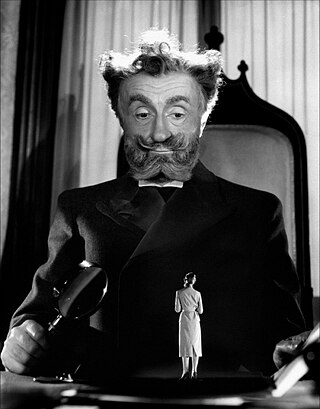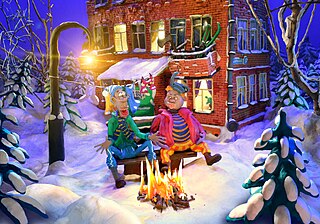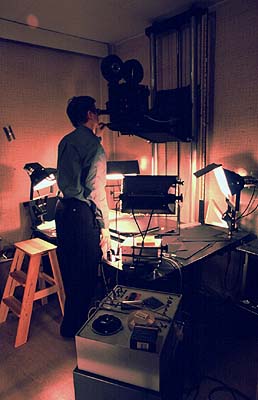
Animation is a filmmaking technique by which still images are manipulated to create moving images. In traditional animation, images are drawn or painted by hand on transparent celluloid sheets (cels) to be photographed and exhibited on film. Animation has been recognized as an artistic medium, specifically within the entertainment industry. Many animations are computer animations made with computer-generated imagery (CGI). Stop motion animation, in particular claymation, has continued to exist alongside these other forms.

Computer animation is the process used for digitally generating moving images. The more general term computer-generated imagery (CGI) encompasses both still images and moving images, while computer animation only refers to moving images. Modern computer animation usually uses 3D computer graphics.

Stop motion is an animated filmmaking technique in which objects are physically manipulated in small increments between individually photographed frames so that they will appear to exhibit independent motion or change when the series of frames is played back. Any kind of object can thus be animated, but puppets with movable joints or plasticine figures are most commonly used. Puppets, models or clay figures built around an armature are used in model animation. Stop motion with live actors is often referred to as pixilation. Stop motion of flat materials such as paper, fabrics or photographs is usually called cutout animation.

Special effects are illusions or visual tricks used in the theatre, film, television, video game, amusement park and simulator industries to simulate the imagined events in a story or virtual world. It is sometimes abbreviated as SFX, but this may also refer to sound effects.

An animator is an artist who creates multiple images, known as frames, which give an illusion of movement called animation when displayed in rapid sequence. Animators can work in a variety of fields including film, television, and video games. Animation is closely related to filmmaking and like filmmaking is extremely labor-intensive, which means that most significant works require the collaboration of several animators. The methods of creating the images or frames for an animation piece depend on the animators' artistic styles and their field.

Pixilation is a stop motion technique in which live actors are used as a frame-by-frame subject in an animated film, by repeatedly posing while one or more frame is taken and changing pose slightly before the next frame or frames. The actor becomes a kind of living stop-motion puppet. This technique is often used as a way to blend live actors with animated ones in a movie, such as in The Secret Adventures of Tom Thumb by the Bolex Brothers.
The history of animation, which is the method for creating moving pictures, has an early history and modern history, beginning in 1888 with the advent of celluloid film. The main focus of this article the history of animation post-1888.
Visual effects is the process by which imagery is created or manipulated outside the context of a live-action shot in filmmaking and video production. The integration of live-action footage and other live-action footage or CGI elements to create realistic imagery is called VFX.

William Gale Vinton was an American animator and filmmaker. Vinton was best known for his Claymation work, alongside creating iconic characters such as The California Raisins. He won an Oscar for his work alongside several Emmy Awards and Clio Awards for his studio's work.

Claymation, sometimes called clay animation or plasticine animation, is one of many forms of stop-motion animation. Each animated piece, either character or background, is "deformable"—made of a malleable substance, usually plasticine clay.

Traditional animation is an animation technique in which each frame is drawn by hand. The technique was the dominant form of animation, until the final few years of the 20th century, when there was a shift to computer animation in the industry, specifically 3D computer animation.

Cutout animation is a form of stop-motion animation using flat characters, props and backgrounds cut from materials such as paper, card, stiff fabric or photographs. The props would be cut out and used as puppets for stop motion. The world's earliest known animated feature films were cutout animations, as is the world's earliest surviving animated feature Die Abenteuer des Prinzen Achmed (1926) by Lotte Reiniger.
Go motion is a variation of stop motion animation which incorporates motion blur into each frame involving motion. It was co-developed by Industrial Light & Magic and Phil Tippett. Stop motion animation can create a distinctive and disorienting staccato effect because the animated object is perfectly sharp in every frame, since each frame is shot with the object perfectly still. Real moving objects in similar scenes have motion blur because they move while the camera's shutter is open. Filmmakers use a variety of techniques to simulate motion blur, such as moving the model slightly during the exposure of each film frame, or placing a glass plate smeared with petroleum jelly in front of the camera lens to blur the moving areas.
The Ken Burns effect is a type of panning and zooming effect used in film and video production from non-consecutive still images. The name derives from extensive use of the technique by American documentarian Ken Burns. This technique had also been used to produce animatics, simple animated mockups used to previsualize motion pictures, but Burns's name has become associated with the effect in much the same way as Alfred Hitchcock is associated with the dolly zoom.

Motion graphics are pieces of animation or digital footage that create the illusion of motion or rotation, and are usually combined with audio for use in multimedia projects. Motion graphics are usually displayed via electronic media technology, but may also be displayed via manual powered technology. The term distinguishes static graphics from those with a transforming appearance over time, without over-specifying the form. While any form of experimental or abstract animation can be called motion graphics, the term typically more explicitly refers to the commercial application of animation and effects to video, film, TV, and interactive applications.
Strata-cut animation, also spelled stratcut or straticut, is a form of clay animation, itself one of many forms of stop motion animation.

An animation stand is a device assembled for the filming of any kind of animation that is placed on a flat surface, including cel animation, graphic animation, clay animation, and silhouette animation.
The history of computer animation began as early as the 1940s and 1950s, when people began to experiment with computer graphics – most notably by John Whitney. It was only by the early 1960s when digital computers had become widely established, that new avenues for innovative computer graphics blossomed. Initially, uses were mainly for scientific, engineering and other research purposes, but artistic experimentation began to make its appearance by the mid-1960s – most notably by Dr. Thomas Calvert. By the mid-1970s, many such efforts were beginning to enter into public media. Much computer graphics at this time involved 2-D imagery, though increasingly as computer power improved, efforts to achieve 3-D realism became the emphasis. By the late 1980s, photo-realistic 3-D was beginning to appear in film movies, and by mid-1990s had developed to the point where 3-D animation could be used for entire feature film production.

Live-action animated is a film genre that combines live-action filmmaking with animation. Projects that are both live-action and computer-animated tend to have fictional characters or figures represented and characterized by cast members through motion capture and then animated and modeled by animators. Films that are live-action and traditionally animated use hand-drawn, computer-generated imagery (CGI), or stop-motion animation.
Joan Carol Gratz is an American artist, animator, and filmmaker who specializes in clay painting. Gratz is best known for her 1992 Oscar-winning animated short film Mona Lisa Descending a Staircase.












